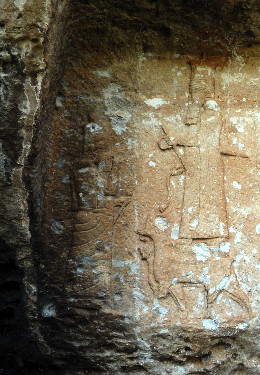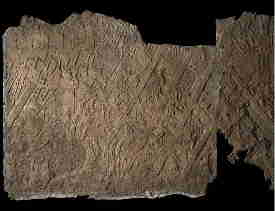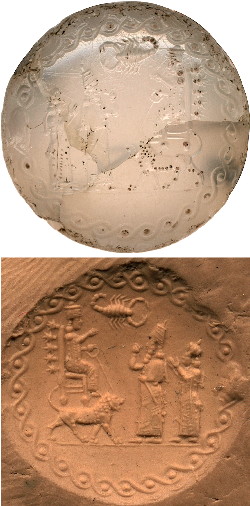Sennacherib, king of Assyria (704–681)
Famous for his ambitious irrigation projects and infamous for his siege of Jerusalem, Sennacherib changed the very foundations of the Assyrian Empire. By promoting the queen and the crown prince to key positions in the empire at the expense of the magnates, he dramatically altered the distribution of power at the core of the state.
His father's chosen heir

Depictions of the Assyrian state god Aššur from the time after Sennacherib's destruction of Babylon in 689 portray him as the master of the Babylonian god Marduk's powers too. In this new double role, Aššur is shown standing on two holy animals: his own traditional lion-dragon and Marduk's snake-dragon (mušhuššu). Sennacherib is praying before him. Detail of a rock relief at Maltai (also known as Halamat) above the city of Dohuk in Northern Iraq, near one of Sennacherib's irrigation projects. Photo by Karen Radner. View large image.
Sennacherib came to the throne of Assyria after his father and predecessor Sargon II (r. 722-705 BC) PGP had died in battle in 705. It was just one year after the court had been moved from Kalhu PGP to Dur-Šarruken PGP . One of Sennacherib's first decisions was to move the royal court and the central administration yet again, this time to Nineveh, whose location and long-distance traffic links made it the natural choice for Assyria's political centre.
The new king was an experienced administrator and politician. Having served as crown prince TT throughout his father's reign, he was accustomed to playing a key role in the Assyrian state. Yet while the change of power was smooth in Assyria, Sennacherib's rule was not so easily accepted in Babylonia. Like Sargon, he laid claim to the title of king of Babylon but there were other pretenders to the throne, such as Marduk-apla-iddin PGP of the Sealand PGP , who enjoyed far more local support.
The "Babylonian problem" was to occupy Sennacherib throughout his reign. His notorious devastation of the city of Babylon PGP in 689 BC marked the end of a series of failed political experiments that were meant to bring the south under Assyrian control. The destruction of Marduk PGP 's temple in Babylon went hand-in-hand with the attempted replacement of Marduk with Aššur PGP in both cult and myth.
Babylonian politics also severely damaged Assyria's relationship with the kingdom of Elam PGP , tenuous at the best of times. The two countries were continually at war during Sennacherib's reign. At Halule PGP , near the modern city of Samarra PGP in central Iraq, the Assyrian troops met the army of Elam, supported by Babylonian and Iranian contingents, in 691. This battle was one of the greatest of antiquity – but did not resolve the underlying conflict.
Sennacherib in the west

The Assyrian army conquering the Judean city of Lachish. Stone decoration of Sennacherib's South-West Palace at Nineveh, room 36, slab 7. British Museum, ME 124906. © The British Museum. View large image on the British Museum's website.
Elsewhere in the empire, Sennacherib's reign was more successful. While he did not make any significant additions to Assyria he was able to consolidate relations with some of its more aggressive neighbours. The most important were the Arab PGP tribes and the expanding Kushite PGP (Nubian) empire, which increasingly threatened Assyrian interests on the eastern Mediterranean coast.
The invasion of Judah and the siege of its capital Jerusalem in 701 BC, famous because of the reports in the Bible, were part of the military and strategic activities aimed at halting the political influence of Kush. The first stages of the campaign were directed against the Phoenician PGP harbour city of Sidon PGP and then against the Philistine centres of Ashkelon PGP and Ekron, where Sennacherib succeeded in establishing pro-Assyrian vassal rulers.
Judah and its king Hezekiah were the next goal, but Jerusalem was never taken. According to the Biblical account, the siege was ended because "an angel of the Lord" brought plague to the Assyrian camp. An account in Herodotus' Histories, written in the 5th century BC, supports the story of an epidemic spreading through the Assyrian camp as the reason for Sennacherib's withdrawal. Despite this turn of events, Hezekiah made peace with Assyria. His country proved a loyal ally until the collapse of the empire at the end of the 7th century.
A champion of his queen

The seal of queen Tašmetu-šarrat, showing the king and queen approaching the goddess Ištar in prayer. Above the scene hovers a scorpion, symbol of the Assyrian queen. White chalcedony stamp seal and its modern impression. British Museum, ME 2002-05-15, 1. Photos by Dick Hodges. View large image.
Excavations at Nineveh have yielded a wealth of Sennacherib's building inscriptions. Today, these are rightly celebrated as excellent sources for the architectural development of Nineveh and for the history of technology. Their main aim, of course, was to present the official Assyrian version of Middle Eastern political history in the early 7th century BC.
Sennacherib's most remarkable inscription is perhaps the one engraved on the lion figures guarding a doorway that leads to a separate wing of the South-West Palace PGP :
"And for queen Tašmetu-šarrat, my beloved wife, whose features Belet-ili PGP has made more beautiful than all other women, I had a palace of love, joy and pleasure built. ... By the order of Aššur, father of the gods, and (the heavenly) queen Ištar PGP may we both live long in health and happiness in this palace and enjoy well-being to the full!"
This unique declaration of love allows us to catch a glimpse at Sennacherib the man, the individual who usually remains hidden behind the official role of the king.
Moreover, Sennacherib's inscription gives his wife Tašmetu-šarrat a prominent position by his side. It is a testament of the increasingly powerful public role of the Assyrian queen, marked by the ever-spreading use of her symbol, the scorpion. Most notably, Sennacherib gave the queen her own standing army to command just like the crown prince. This novel policy was designed to shift power away from the magnates to members of the king's immediate family. The strategy continued under Sennacherib's successors Esarhaddon and Assurbanipal. It created a political climate that differed markedly from the preceding period.
Murder most foul
Who would succeed Sennacherib to the throne? Arguments about this question cast a shadow over the last years of his reign and ultimately cost the king his life. For well over a dozen years, Sennacherib's chosen heir and his designated successor to the Assyrian empire had been his son Arda-Mullissi PGP . But for unknown reasons he was made to resign, and by 683 BC Esarhaddon had been appointed as the new crown prince.
Sennacherib made the whole country take an oath on the new crown prince's behalf. Arda-Mullissi too swore loyalty to his younger brother. Regardless, he lobbied Sennacherib to take back the appointment but the king did not comply. The situation at court was clearly difficult, and Esarhaddon was sent away for his own protection.
Arda-Mullissi, on the other hand, stayed in Nineveh, all the while plotting how to become king of Assyria. Relying on the network of power and the military resources that he had cultivated during his long years as crown prince he decided to take his fate, and the fate of Assyria, into his own hands. On the 20th day of the tenth month of 681 BC, Arda-Mullissi and one of his brothers attacked their father with drawn swords in a temple of Nineveh and slaughtered him. Thus ended Sennacherib's life and his regency over Assyria.
Further reading
- Frahm, 'The Great City', 2008.
- Frame, 'Babylon', 2008.
- Parpola, 'The Murderer of Sennacherib', 1980.
Content last modified: 31 Mar 2025.
Karen Radner
Karen Radner, 'Sennacherib, king of Assyria (704–681)', Knowledge and Power, Higher Education Academy, 2025 [http://oracc.museum.upenn.edu/saao/knpp/Essentials/Sennacherib/]